|

The Fish Car Era of the National
Fish Hatchery System
U.S. Government Printing Office—1979
Author John R. Leonard of the Fish and Wildlife Service's Division
of National Fish Hatcheries acknowledges assistance from the following:
Renee Jaussaud of the National Archives and Ted Fearnow, for historical
information; the Still Pictures Branch of the National Archives,
the Erwin National Fish Hatchery, Ed Forner, Robert Thoesen, and
Monte Stuckey for photographs; and Grace Jackson and Galen Buterbaugh
for the fish car uniform and equipment.
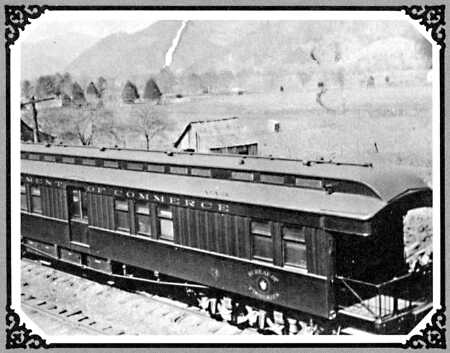 Traveling coast to coast by train is no easy
trip today. But back in 1874, just 5 years after the first transcontinental
rail linkup, the journey was a downright arduous expedition—especially
when tending 35,000 shad fry. For Dr. Livingston Stone of the
U.S. Fish Commission (a forerunner of the U.S. Fish and Wildlife
Service), the trip was also a unique challenge. His job was to
get the fish fry to California safe and sound for planting in
the Sacramento River and other Pacific coastal streams. Traveling coast to coast by train is no easy
trip today. But back in 1874, just 5 years after the first transcontinental
rail linkup, the journey was a downright arduous expedition—especially
when tending 35,000 shad fry. For Dr. Livingston Stone of the
U.S. Fish Commission (a forerunner of the U.S. Fish and Wildlife
Service), the trip was also a unique challenge. His job was to
get the fish fry to California safe and sound for planting in
the Sacramento River and other Pacific coastal streams.
The fish were carried in open milk cans, and Stone changed
the water every 2 hours—if water was available. After days
of such round-the-clock care, most of the shad fry arrived safely.
As a result of the successful experiment, a new species was established
on the West Coast for sports anglers and commercial fishermen.
Nowadays a fleet of modern tank trucks transports more than
200 million fish a year from Fish and Wildlife Service National
Fish Hatcheries to stock many of the nation's rivers, lakes, and
coastal waters. Some 48 species reared by over 90 Federal hatcheries
are carried in cooled, oxygen-aerated, constantly circulated and
cleansed water. Indeed, the science of fish transportation has
been so highly developed by fisheries experts that virtually all
of the fish arrive at stocking points in sound condition.
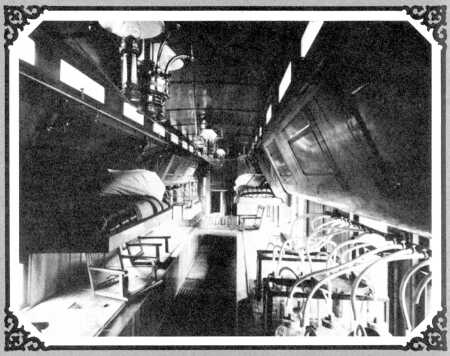 Things were different a century ago. The science
was still young. And it was the beginning of what a few Fish and
Wildlife Service veterans can fondly recall as the "Fish
Car Era." The problem in 1872, when the U.S. Fish Commission
was first set up, was how to quickly move fish from hatcheries
to far-off waters throughout the country. Because of transport
limitations, fish were generally first planted in areas near the
rearing stations. Things were different a century ago. The science
was still young. And it was the beginning of what a few Fish and
Wildlife Service veterans can fondly recall as the "Fish
Car Era." The problem in 1872, when the U.S. Fish Commission
was first set up, was how to quickly move fish from hatcheries
to far-off waters throughout the country. Because of transport
limitations, fish were generally first planted in areas near the
rearing stations.
Pioneers like Stone and others soon devised techniques to safely
carry fish long distances. In 1879, for example, Stone successfully
shepherded a shipment of striped bass from New Jersey to California.
During the lengthy train journey, the milk cans containing the
fry were cooled by ice. Fellow passengers were hired by Stone
to help aerate the water by hand. A few years later he took another
shipment of fish across the country. But this time a new aerating
device was used. A cylinder with tiny holes in the bottom was
filled with water and held over the cans, releasing a fine spray
of air enriched water.
It was clear by then that fish could be effectively transported
by rail. The basics of the science were evolving. Most important,
the water in fish containers required frequent aeration. A suitable
water temperature was necessary. And the importance of adding
ice to the water was recognized. The colder water both absorbed
more oxygen and also reduced the oxygen needs of the fish. The
water had to be kept free of slime and impurities. Before being
loaded, it was helpful to confine the fish for a few days without
food.
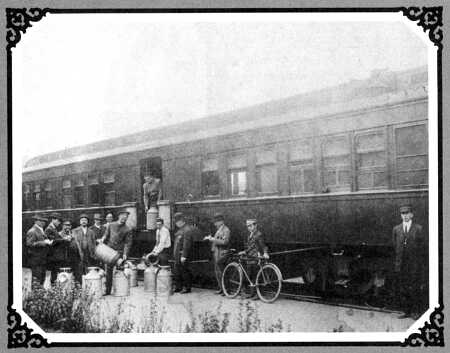 Rail shipments
of fish increased as the interest in "managing" streams
and lakes spread. Containers were shipped in baggage cars, accompanied
by Government fish culturists who were called "messengers."
Their task was to aerate the water and generally make sure their
live cargoes arrived in sound condition. With the volume of such
traffic steadily rising, the Fish Commission decided in 1881 to
purchase a "fish car"—a baggage car specifically
equipped for carrying fish. Rail shipments
of fish increased as the interest in "managing" streams
and lakes spread. Containers were shipped in baggage cars, accompanied
by Government fish culturists who were called "messengers."
Their task was to aerate the water and generally make sure their
live cargoes arrived in sound condition. With the volume of such
traffic steadily rising, the Fish Commission decided in 1881 to
purchase a "fish car"—a baggage car specifically
equipped for carrying fish.
The improved efficiencies and economies of the first fish car
were compelling. In 1882, the Commission invested $7,334 in a
new and improved version. Fish Car No. 2, built by the Baltimore
and Ohio Railroad, was fitted with special compartments to hold
ice. The car was reinforced so it could carry as much as 20,000
pounds of fish, water, and equipment at passenger train speeds.
From that time on, until the "Fish Car Era" ended, Federally
raised fish traveled first class in railroad cars designed for
their health and comfort—along with their human attendants.
So successful was Fish Car No. 2 that a third coach was built
in 1884 and added to the fleet. This car could not only carry
fish but also fish eggs which would be hatched in transit. The
first trial came in 1886 when 600,000 shad eggs were sent from
the Battery Station on the Susquehanna River in Maryland to Portland,
Oregon. The eggs had hatched and become thriving fish fry by the
time they reached their destination for stocking in the Columbia
and Willamette Rivers.
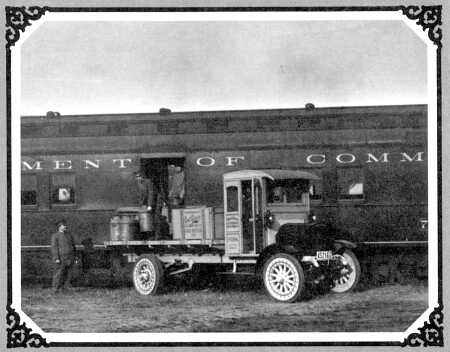 The rise in
the number of Government hatcheries prompted the purchase of another
fish car in 1893. Each car was more advanced than its predecessor.
Car No. 4, for instance, had cedar tanks, an air pump to aerate
the water, and other special equipment. At the turn of the century,
the Fish Commission had become the Bureau of Fisheries, and two
more cars had been acquired. The rise in
the number of Government hatcheries prompted the purchase of another
fish car in 1893. Each car was more advanced than its predecessor.
Car No. 4, for instance, had cedar tanks, an air pump to aerate
the water, and other special equipment. At the turn of the century,
the Fish Commission had become the Bureau of Fisheries, and two
more cars had been acquired.
By this time, the fish cars were crisscrossing the country,
sometimes en route as long as 10 days (with fish losses held down
to only 1 percent). They generally operated from April through
November. During the other 4 months of the year, the cars were
laid up for repair and maintenance.
Each car, which could carry about 150 10-gallon cans containing
some 15,000 3-inch fish, was like a little self-contained world
on wheels. The five-man crew included a fish car "captain,"
several "messengers," and a cook. They traveled, ate,
and slept in comfort. One car even became a honeymoon coach for
an employee and his new bride. As the fish car rumbled toward
the Valley City Hatchery in North Dakota, the crew's cook prepared
a wedding feast in his little galley. Fish delivery service was
free of charge. A shipment would be picked up by recipients at
the rail station nearest to where the fish were being stocked.
If no rail terminus was nearby, a fish car messenger would unload
25 or 30 pails of fish and transport the shipment to a more convenient
pickup point. The applicants receiving the fish would be notified
ahead of time by telegraph. Given the vagaries of rail travel,
there were occasionally missed connections. But the great bulk
of the fish were successfully planted.
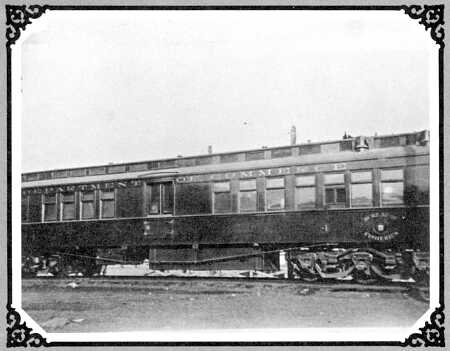 Railroads welcomed
the fish cars, generally charging only 20 cents a mile to haul
the cars and their crews. Indeed, the railroads so appreciated
the benefits of having the waters along their routes stocked for
free that they levied no charge for up to 50 percent of the annual
fish car mileage. Messengers accompanying "detached"
shipments rode for reduced rates, or at no cost. And the emptied
cans and pails used in hauling the fish were shipped back to the
Commission free. Railroads welcomed
the fish cars, generally charging only 20 cents a mile to haul
the cars and their crews. Indeed, the railroads so appreciated
the benefits of having the waters along their routes stocked for
free that they levied no charge for up to 50 percent of the annual
fish car mileage. Messengers accompanying "detached"
shipments rode for reduced rates, or at no cost. And the emptied
cans and pails used in hauling the fish were shipped back to the
Commission free.
The uniquely outfitted cars themselves became attractions,
participating at various festivals and exhibitions such as the
New Orleans Exhibition of 1885, the Chicago World's Fair in 1893,
and the 1901 Pan American Exposition in Buffalo, New York. At
times, though, the cars were less appreciated by railroad men.
With their novel cargoes, the fish cars were much heavier than
normal passenger coaches. And in spite of precautions, they were
involved in several accidents.
Fish Car No. 4, for example, weighed 42,780 pounds. One of
the heaviest railroad cars in the country, it was blamed for a
1911 wreck near Bridgeport, Connecticut, which killed 13 people
and injured 48. The excessive weight of the car had purportedly
delayed the Federal Limited for an hour. The engineer,
anxious to make up the lost time, was reportedly speeding 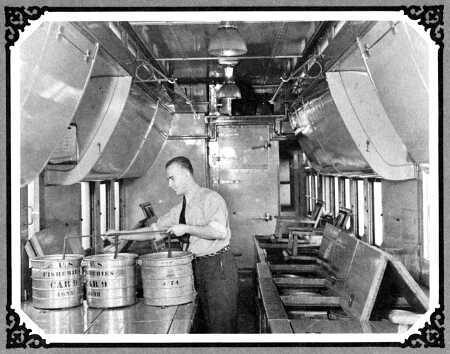 when the wreck occurred.
According to a newspaper account, the car had been involved in
at least one other near-accident and was regarded as a veritable
"hoodoo" by railroaders. Later investigation showed
Car No. 4's allegedly unlucky past was more fiction than fact. when the wreck occurred.
According to a newspaper account, the car had been involved in
at least one other near-accident and was regarded as a veritable
"hoodoo" by railroaders. Later investigation showed
Car No. 4's allegedly unlucky past was more fiction than fact.
The modern "Fish Car Era" was ushered in with the
delivery in 1916 of the first steel car, Fish Car No. 7, which
had a fish-carrying capacity of 50 percent more than the existing
wooden models. Indeed, a number of railroads were becoming reluctant
(for safety reasons) in those years to hook the older wooden cars
to their high-speed passenger trains. So three were replaced by
new steel cars with advanced equipment and twice the fish-carrying
capacity.
The technology of fish transportation was also changing. By the
early 1920s, the traditional 10-gallon milk can containers were
succeeded by new lightweight containers called "Fearnow"
pails. These containers weighed only 5 pounds but could carry
twice as many fish as the older milk cans, while taking up half
the space. Moreover, each "Fearnow" pail had a special
built-in compartment for ice to keep the water cool. At the same
time, the manual aeration of water in the containers began to
be replaced by more modern methods—electric or jet aerators
that used compressed air. Several of the new steel cars used air
from the train lines to aerate the fish.
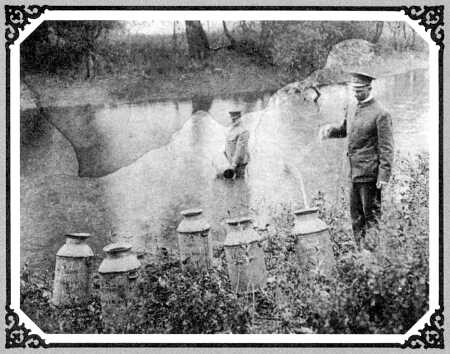 By the early
1920s, the fish cars had accumulated an impressive record. A 1923
report indicated that, over the previous 20 years, the output
of the various hatchery activities amounted to 72,281,380,861
fish which were distributed by fish cars traveling 2,029,416 miles
and detached messengers 8,104,799 miles. Most of the shipments
were made up of freshwater or anadromous fishes—pike, perch,
shad, whitefish, trout, carp, landlocked salmon, and others. Regional
resources were exchanged. Lobsters and blue crabs, for instance,
were carried from Woods Hole, Massachusetts, to San Francisco,
and dungeness crabs from San Francisco to the Chesapeake Bay.
Such "transfers," to enrich the aquatic potential of
one region or another, were common. Non-native species such as
brown trout, shad, and carp were introduced in various areas.
The cars were also a key link in the distribution of fish to private
organizations and local government agencies, as well as aquariums
and public exhibitions. By the early
1920s, the fish cars had accumulated an impressive record. A 1923
report indicated that, over the previous 20 years, the output
of the various hatchery activities amounted to 72,281,380,861
fish which were distributed by fish cars traveling 2,029,416 miles
and detached messengers 8,104,799 miles. Most of the shipments
were made up of freshwater or anadromous fishes—pike, perch,
shad, whitefish, trout, carp, landlocked salmon, and others. Regional
resources were exchanged. Lobsters and blue crabs, for instance,
were carried from Woods Hole, Massachusetts, to San Francisco,
and dungeness crabs from San Francisco to the Chesapeake Bay.
Such "transfers," to enrich the aquatic potential of
one region or another, were common. Non-native species such as
brown trout, shad, and carp were introduced in various areas.
The cars were also a key link in the distribution of fish to private
organizations and local government agencies, as well as aquariums
and public exhibitions.
Ironically, the queen of the fleet was delivered shortly before
the "Fish Car Era" began to wane. Fish Car No. 10, a
$59,000 behemoth built in 1929, stretched 81 feet. Its insulated
compartments could hold 325 cans containing 34,000 3-inch fish
or 500,000 1-inch fish. The car even had its own generator to
operate all the equipment, including the electric aerating devices.
The shiny new No. 10 and the other fish cars seemed to burn up
the rails as the decade came to a close. During one 2 -month period,
according to the records, "fish were sent to virtually every
State in the Union, and the cars were kept busy day and night."
The cars and the messengers together covered an astonishing 505,853
miles in fiscal year 1930.
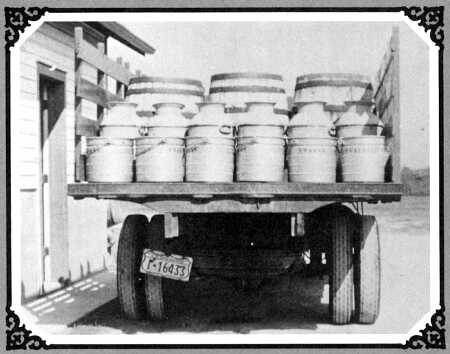 Still, No. 10
was the last fish car ever constructed. In 1928, 27,000 brook
and rainbow trout were transported by airplane from Northville,
Michigan, to Dayton, Ohio, without a single loss. The successful
flight showed that fish could be quickly and safely carried long
distances by air. More important was the growing distribution
by truck. In 1930, the vehicles were limited to a 60-mile radius
of a hatchery. But by 1932, improvements in the trucks, together
with favorable cost comparisons, were making an increasing impact.
Some 17 percent of the output of hatcheries was hauled by truck
in 1933. Meanwhile, budget cutbacks were restricting fish car
operations. By 1937, modernized tank trucks were equaling the
mileage of the fish car rail fleet. Still, No. 10
was the last fish car ever constructed. In 1928, 27,000 brook
and rainbow trout were transported by airplane from Northville,
Michigan, to Dayton, Ohio, without a single loss. The successful
flight showed that fish could be quickly and safely carried long
distances by air. More important was the growing distribution
by truck. In 1930, the vehicles were limited to a 60-mile radius
of a hatchery. But by 1932, improvements in the trucks, together
with favorable cost comparisons, were making an increasing impact.
Some 17 percent of the output of hatcheries was hauled by truck
in 1933. Meanwhile, budget cutbacks were restricting fish car
operations. By 1937, modernized tank trucks were equaling the
mileage of the fish car rail fleet.
There was no holding back progress. The hard reality was that
distributing fish by truck was less costly and more efficient
than using the traditional fish cars. As a 1939 Bureau of Fisheries
report put it, "The same number of fish can be carried by
truck as by distribution car, to destinations within a radius
of approximately 300 miles, at about one-fourth the cost."
With Federal hatcheries now located in many States throughout
the country, most shipments did not have to be carried much more
than 300 miles.
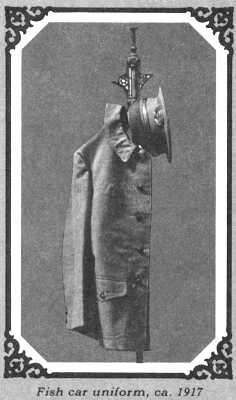 By 1940, only
three fish cars were still operating. One of the cars was wrecked
in 1944. The fate of another is unknown. The last fish car, the
mammoth No. 10 which was the pride of the fleet, was finally taken
out of service in 1947, its equipment scattered among the various
hatcheries. By 1940, only
three fish cars were still operating. One of the cars was wrecked
in 1944. The fate of another is unknown. The last fish car, the
mammoth No. 10 which was the pride of the fleet, was finally taken
out of service in 1947, its equipment scattered among the various
hatcheries.
An era had come to a close, in the name of greater efficiency.
Indeed, for the Fish and Wildlife Service veterans who manned
the fish cars, the disappearance of car No. 10 marked the end
of a unique and romantic way of life. The fish cars may have become
outmoded. But for 66 years they had played a key role in enriching
the nation's natural resources and in the process, created a proud
tradition.
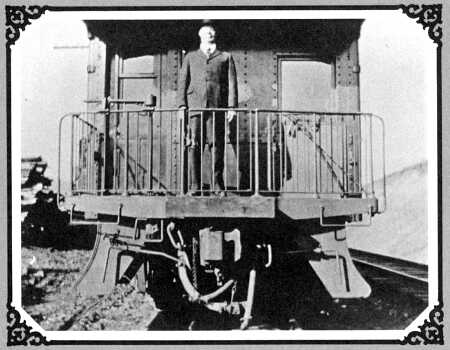
Stories Page | Contents Page
|







